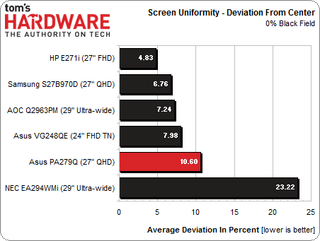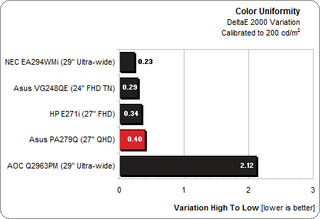Asus ProArt PQ279Q Monitor Review: 27-Inch, Wide-Gamut, QHD
Results: Viewing Angle And Uniformity
Since this is an IPS-based panel, we expect to see excellent off-axis viewing performance. Unfortunately, the GB-r-LED backlight seems to have a slightly negative effect on this.

The result we observe is a little unexpected. There is a slight red shift from side to side, and a slight blue shift from top to bottom. It’s subtle to be sure, but it is there. We can only theorize that this is a product of the PA279Q’s unusual two-color LED backlight. Since all of the light coming from an LCD panel is polarized, it follows that two different wavelengths emanating from the screen will shift differently as the viewing angle increases. There is no LCD panel that looks perfect in this test, which is part of why Asus bundles a hood with the PA279Q. To properly judge color on this or any panel, you need to be sitting front-and-center.
To measure screen uniformity, zero-percent and 100-percent full-field patterns are used, and nine points are sampled. In a change from previous reviews, we compare the results to other monitors we’ve measured. First, we establish a baseline measurement at the center of each screen. Then the surrounding eight points are measured and their values expressed as a percentage of the baseline, either above or below. This number gets averaged. It is important to remember that we only test the review sample each vendor submits. Other examples of the same monitor can measure differently in this metric.
Since the PA279Q has a uniformity compensation option, we measured the monitor both ways. This option is not available in the sRGB or Adobe RGB modes, only in Standard or User.
First up is black field uniformity.

This number represents the sRGB mode, so compensation is not active. When we switch to a calibrated User mode and turn that feature on, the black field uniformity improves to 8.39 percent. However, black level increases as well. We feel the gain in uniformity isn’t worth a visible rise in black level.
Here’s the white field measurement, again in the sRGB mode.
Stay on the Cutting Edge
Join the experts who read Tom's Hardware for the inside track on enthusiast PC tech news — and have for over 25 years. We'll send breaking news and in-depth reviews of CPUs, GPUs, AI, maker hardware and more straight to your inbox.

This is another excellent result. When you switch to User mode and turn compensation on, the percentage drops to 3.40. But the white level increases too, necessitating a brightness control adjustment. After experimenting with all of the available options, we still feel the fixed sRGB and Adobe RGB modes are the way to go.
Screen Uniformity: Color
Starting with our review of AOC's Q2963PM, we added a new uniformity test to our benchmark suite: color. The above measurements only address luminance. Now we’re measuring the white balance variation in an 80-percent white field pattern. The results are expressed as a variation in Delta E (in other words, the difference between the highest and lowest values). We didn’t perform this test on the Samsung S27B970D, so we can’t include it here.

With a variance of only .40 Delta E, the color variation across the screen is essentially nil. This is another important metric for any pro-level monitor and the PA279Q certainly qualifies. If you’re curious about the effect of the uniformity compensation feature, our result was an incredible .08 Delta E variation! It’s too bad this option isn’t available in sRGB or Adobe RGB mode.
Current page: Results: Viewing Angle And Uniformity
Prev Page Results: Color Gamut And Performance Next Page Results: Pixel Response And Input Lag
Christian Eberle is a Contributing Editor for Tom's Hardware US. He's a veteran reviewer of A/V equipment, specializing in monitors. Christian began his obsession with tech when he built his first PC in 1991, a 286 running DOS 3.0 at a blazing 12MHz. In 2006, he undertook training from the Imaging Science Foundation in video calibration and testing and thus started a passion for precise imaging that persists to this day. He is also a professional musician with a degree from the New England Conservatory as a classical bassoonist which he used to good effect as a performer with the West Point Army Band from 1987 to 2013. He enjoys watching movies and listening to high-end audio in his custom-built home theater and can be seen riding trails near his home on a race-ready ICE VTX recumbent trike. Christian enjoys the endless summer in Florida where he lives with his wife and Chihuahua and plays with orchestras around the state.
-
Sid Jeong I think it's gonna be a hit with small studios and many freelance designers. I'd consider it when I upgrade my monitor in the future.Reply -
zentrope People who cannot buy Eizo,Nec,Lacie...Reply
And are not happy with Dell and HP...
You should be smiling now!
Also at some places you can even get this around $800.. -
slomo4sho It appears that my three Asus VS238H-P which cost me $360 total are going have a fairly long life span since 1440P still demands a hefty premium over quality 1080P displays. Hopefully we get some quality 4k displays for around 1k soon, the ASUS PQ321Q needs some competition :)Reply -
amgsoft What is the actual reason for calibrating at 200 cd/m2. The usual standard calibration is 120 cd/m2 at 6500K, see http://en.wikipedia.org/wiki/Color_calibration.Reply -
JeanLuc The same panel can be found in Korean import models such as the Achieva Shimian QH2700-IPSMS which is roughly half the price. I would love to see Toms benchmark these premium panels against the cheap imports.Reply -
JackNaylorPE Almost perfect ....When it comes in 144hz or greater, call me .Reply
Liking the new Eizo model w/ 240 Hz mode too. -
lhughey I want a QHD monitor, but I can't afford a gaming card that will work well with that resolution just yet. Maybe in a six months when Nvidia drops its Maxwell cards.Reply -
Nintendo Maniac 64 Am I the only one that wants to know about upscaling quality? Last time I checked most monitors upscale pretty badly, and considering that this has an HDMI input I don't think it'd be unthinkable to have a 720p or a 1080p external video source.Reply -
Bondfc11 Why doesn't Tom's do the Overlord Tempest 2560x1440 IPS that will overclock refresh rates up to 120Hz? they are sellign for like $500 now and are killer!Reply
Most Popular

